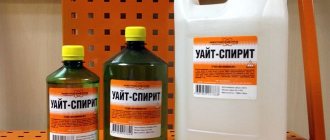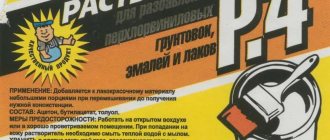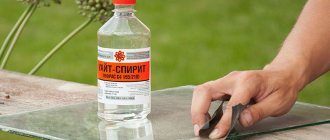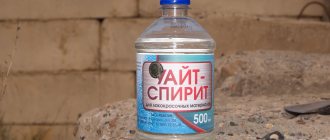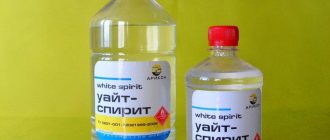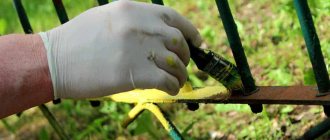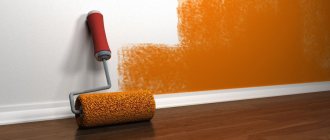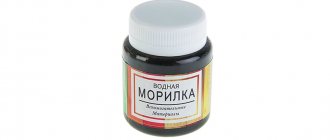After construction work, underused oil paint is often left behind. Over time, it changes its properties, becomes thick or completely solidifies. And the question arises: how should oil paint be diluted so that you can work with it again?
You need to dilute it with whatever is in the paint base.
Is it possible to degrease with white spirit?
Of course, yes - it degreases. White spirit is one of the most popular solvents used for degreasing surfaces of various materials. Unlike its analogues (acetone, kerosene), it has quite attractive performance properties.
Interesting materials:
How to clean white laundry? How to clean white shoe soles? How to remove suede paint from white soles? How to clean grass from white soles? How to clean white dishes from plaque? How to clean white rubber sole? How to clean white rubber on sneakers? How to clean white fabric on sneakers? How to clean dirt from white jeans? How to clean white sneakers?
Instructions on how to properly dilute paint
Paint that has become thick, dense and heavy over time will have poor adhesion to the surface during use.
- Its consistency becomes lumpy, and this will not allow you to get an even, beautiful coating.
- Otherwise, applying such paint will be quite problematic, and over time it will completely fall off the wall surface.
- To prevent this from happening, and to ensure that the work progresses easily and quickly, the paint must be diluted before use.
When diluting the material, it is very important not to overdo it, otherwise it will lose its elasticity and become too liquid. In addition, the paint will take a long time to dry, its coating will be sticky and short-lived. As a result, both the material and the surface will be hopelessly damaged.
Why do you need a thinner for oil painting?
Before answering this question, let's figure out what a thinner for oil paints is, and how it differs from a solvent.
A solvent is a liquid that dissolves certain binders in paint, giving it the desired consistency.
The thinner dilutes the paint, reducing the viscosity of the material so that the paint can be used without problems.
Thinners for oil paints
It is also used to clean paint from brushes, palettes and other painting tools. But, since the thinners themselves are quite expensive, especially the tee, brushes can be cleaned using cheaper methods.
In other words, a regular thinner actually changes the consistency of the paint, its astringent properties, but does not change its structure. After drying, the paint remains the same. The thinner simply helps spread the paint across the canvas.
Why then do you need a solvent?
The solvent (hence the name) dissolves oily substances in the paint, which is why, after drying, the paint layer may differ from what you initially expected.
There are a huge variety of thinners in the world of painting, but there are the most basic ones that most artists use. Let's look at each in more detail.
Useful tips from a painter
After opening the container, the paint must be thoroughly mixed and then its condition must be assessed. During storage, it could separate, thicken and clump, and some of its components could sink to the bottom.
- Before you start thinning the paint, it is important to check its components for compatibility in order to avoid oxidation of the material. To do this, pour a little paint into a tray and dilute it with the chosen product. If the material has curled, it should not be used.
- It is better to prepare a small amount of material, this will help you not make mistakes in the calculations and not spoil the material.
- When working with solvents, you should take safety precautions; for this you need to use safety glasses, gloves, a respirator and work clothes. Good ventilation in the room will also be required, since these products are toxic and can adversely affect human health.
- Over time, the paint may thicken again, in which case the solvent can be used again.
- Paint that has dried and become as strong as stone should be diluted with the necessary product and left for two to three days. After this, mix thoroughly and evaluate its condition. If the paint has become more viscous and viscous, then it can be used to cover surfaces: greenhouses, garages, workshops, etc.
Thinning paint is a simple, but quite responsible process. It is important to monitor the consistency and strictly adhere to the manufacturer's recommendations.
Do not forget about safety measures, as toxic fumes from paint and thinners can negatively affect human health.
Solvent properties
Turpentine has a strong specific odor because it contains pine resin. For this reason, it should be used outdoors.
- White spirit preserves the original paint color and elasticity. It functions as both a paint thinner and a solvent, so it is convenient to clean the tool after work.
- Solvent 647 contains chemical components, which is why it has a strong, persistent odor. When working with it, you must ensure good ventilation. To achieve good paint uniformity, you need to mix it thoroughly.
- Gasoline and kerosene are a budget diluent option and have a simple composition. But at the same time, they are toxic flammable materials that require precise mixing proportions with paint.
- Drying oil is an oil-based thinner. Suitable for any type of paint. Together with paint it gives a durable and elastic coating.
- Water is suitable as a solvent for water-based paints.
Advantages and disadvantages of drying oil for painting
It is better to use oil-based paint based on drying oil. It acts as both a coloring and impregnating agent. This product appeared in Soviet times. It covered literally every surface in the room. Nowadays, a hardware store can offer a large number of variations of paint and varnish mixtures. Let's consider the advantages of drying oil for paint:
Despite the fact that it is possible to apply another paint coating to it, there are also disadvantages in this product:
Despite the presence of positive and negative sides of the product, most builders use drying oil as an initial coating, and then apply a coloring agent. To choose the right paint for this process, let’s analyze the features of this process.
Dilution features
The basis of oil paint is pigment mixed with drying oil until smooth. While the mixture is not being used, the heavy powder pigment can settle, the middle hardens, and oil accumulates on top, so you need to thoroughly stir or shake the jar before working. If you need to bring the coloring substance to a more liquid state, first answer two questions:
It is important for us to decide on these points, since oil paint should be diluted with a substance similar to what is in the composition.
If a can of paint and varnish material has been standing for a short time after opening, then the thickening is eliminated by adding drying oil. However, this substance differs in the manufacturing method, so if you choose the wrong one, you risk ruining the entire coloring material. When it is necessary to revive heavily compacted paint, you cannot do without a solvent. We also add it if we are preparing a primer.
Surface preparation
The importance of pre-treatment of the oiled surface has been discussed more than once. Only a short-sighted amateur who does not feel sorry for his wasted efforts and money on materials can omit the preparatory stages. A thrifty owner would prefer to do everything once, but thoroughly and well.
So, here is the sequence in which the processing work needs to be carried out:
These carefully completed stages will greatly facilitate the application of paint and prevent their deformation throughout their entire service life.
How to properly dilute paint
To work, you will need a rectangular container. It is more convenient to dilute and mix paint.
It is important that the container has a streamlined shape, because material can accumulate in the corners, resulting in a heterogeneous mass.
- It is necessary to prepare a measuring cup with clear measuring markings.
- Next, mix the paint thoroughly; you can use a wooden spatula for this.
- Pour in the thinner in a thin stream, while simultaneously stirring the material, and evaluate the resulting consistency.
- If it has a moderately viscous and fluid composition, then the paint is ready for use.
Surface preparation
The importance of pre-treatment of the oiled surface has been discussed more than once. Only a short-sighted amateur who does not feel sorry for his wasted efforts and money on materials can omit the preparatory stages. A thrifty owner would prefer to do everything once, but thoroughly and well.
So, here is the sequence in which the processing work needs to be carried out:
These carefully completed stages will greatly facilitate the application of paint and prevent their deformation throughout their entire service life.
